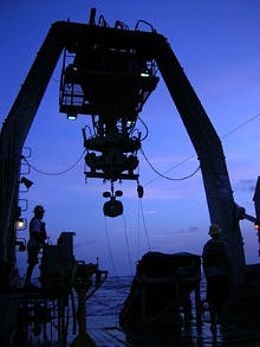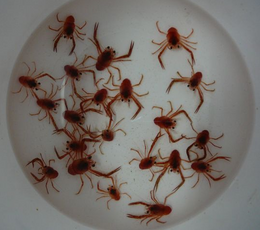Head of the Research Unit:
Prof. Dr. Thorsten Reusch
GEOMAR Helmholtz Centre for Ocean Research Kiel
Wischhofstr. 1-3
24148 Kiel
Telefon: 0431 600-4550
Raum: 5-1.502
E-Mail: treusch(at)geomar.de
Team Assistant OEB:
N.N.

From tiny cells to large drifting animals, plankton organisms shape oceanic ecosystems and biogeochemical fluxes. Their interactions and behaviors determine how much carbon dioxide is fixed - and how much is transferred into the food web or exported into the deep sea. We use a suite of observational methods in the field, including bottle and net sampling (Fig. 1) as well as in situ optical and acoustic systems. With these, we determine how planktonic organisms are distributed in the ocean in relation to environmental drivers, e.g. low-oxygen eddies. Using data on abundance and vertical migration as well as species-specific metabolic rates under in situ conditions, we estimate their impact on elemental cycling in the water column, both in the sunlit surface and in the twilight and dark zones. Some pelagic organisms migrate vertically over hundreds of meters every morning and evening and contribute substantially to carbon transport. In some regions, however, they need to endure extremely low oxygen concentrations, which significantly reduces their activity (Fig. 2). This research area is led by Dr. Helena Hauss (who is also pictured in the Dark Ocean Research Topic photo).

(Fig. 2) Pelagic squad lobsters (Pleuroncodes monodon), a species able to tolerate anoxia for half a day - every day! Photo: H.Hauss
Other studies in this area are on the diversity and interactions of surface ocean microbes – including algae and their predators as well as other entities, such predators and their symbionts and viruses. This area is led by Alexandra Worden with participation from several team members, including Camille Poirier (now at Oxford), Susanne Wilken (now a Professor in Amsterdam), Kristin Bergauer (now a group lead at GEOMAR) and on the analysis side David Needham (now a Junior Professor at University of Kiel). We use multiple approaches, including Stable Isotope Probing (SIP) and at sea single-eukaryote cell sorting to tease apart interactions between protists and other biological entities in the sea. For more information please visit wordenlab.org. Sorting is followed by DNA sequencing and, from there, characterization of genomes, protein functions and transcriptional activities in the field (Fig. 3). IN Collaboration with the Alm lab at MIT we are developing additional approaches as well.Some of our work in this area can be seen at Needham et al. PNAS 2019, Needham et al Proceedings of the Royal Academy B. Understanding interactions is important for then being able to predict the fate of fixed carbon – does it end up being exported into the deep sea, or is it respired while still in the surface ocean?
Dr. David Needham, a Helmholtz Young Investigator Group in OEB, is exploring the specificity and prevalence of microbe-to-microbe interactions through high-throughput approaches. Such approaches include efforts to use "single-cell" resolved data to quantify and identify physical interactions (e.g., symbioses, infection) among microbes, as well as experiments to understand microbiological responses to changing environmental conditions. This research, embedded in diverse time-series contexts, will advance an understanding of how marine microbe-to-microbe interactions change over space and time as well as the biological and ecological mechanisms involved, with implications to ecosystem productivity and carbon export. Publications on population and single cell methods using flow cytometric sorting have been developed exclusively in in Alex's lab have whereas David's lab is pursuing other high throughput methods that long term will likely be more cost and time effective than cytometry.

